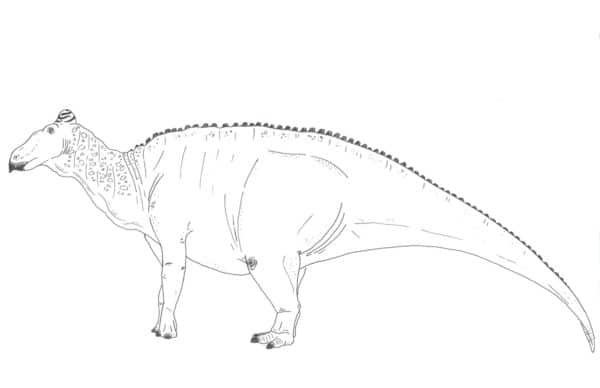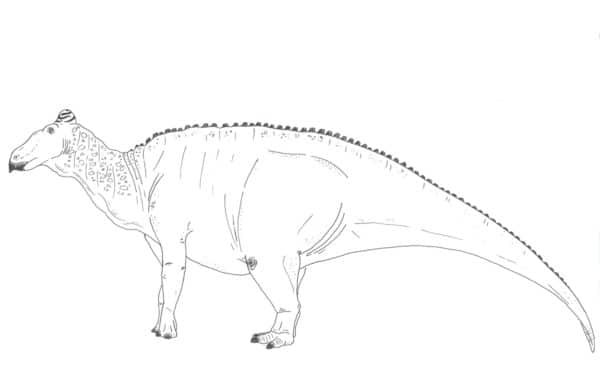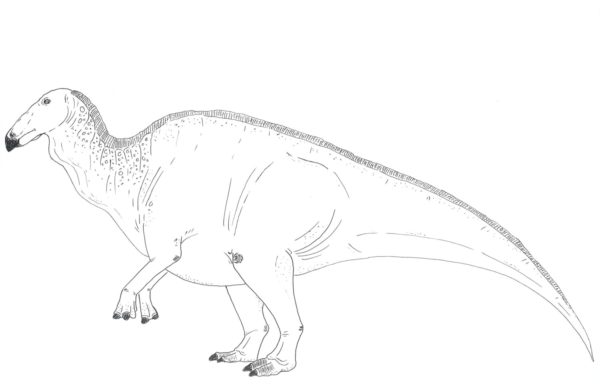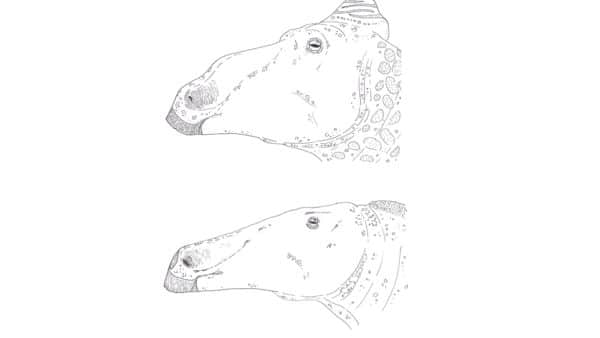
In the last article, we talked about the taxonomic confusion surrounding North American troodontids, and how this uncertainty is just now being resolved. What might come as a surprise to many readers is that the common hadrosaurid dinosaur Edmontosaurus, also known since the early days of paleontology in North America, has just as convoluted a history. It’s taken some miraculous discoveries and a lot of effort from paleontologists both past and present to work out the classification of this dinosaur and to overturn the myths and misconceptions surrounding its biology. Edmontosaurus, in turn, has rewarded paleontologists with a better understanding of dinosaur biology than nearly any extinct animal.
In a way, Edmontosaurus is kind of the ‘classic’ duck-billed dinosaur. With its long, flat skull and big duck-like beak, it’s pretty vanilla compared to some other hadrosaurs with their elaborate crests. It was named in 1917, but remains of Edmontosaurus have trickled into eastern laboratories ever since the late 19th century. Some of the first described skeletal material from this genus, recovered from Wyoming, was studied in 1892 by the Charles Forster Kane of paleontology himself, Othniel Charles Marsh. At the time, he believed this material belonged to a genus of hadrosaur from older rocks in Kansas he’d described twenty years before called Claosaurus, so the younger Wyoming dinosaur was named Claosaurus annectens (Marsh, 1892). At this time, hadrosaurs were still poorly understood, and it wouldn’t be until the early 20th century that many beautiful articulated duckbills would be collected from southern Alberta.
Scrappy hadrosaur fragments from out west, many of them teeth or bits of vertebrae, wound up in the hands of America’s earliest paleontologists. In the race to claim as many new fossil animals as possible, Marsh and his nemesis Edward Drinker Cope slapped dozens of names on these fragmentary bones, many of which were coming from the same few types of dinosaurs. Bits of hadrosaurs from the end of the Cretaceous were named Trachodon, Cionodon, Diclonius, Pteropelyx, and Thespesius, none of which are in use anymore. Failing to see much in the way of diversity in these fossils, in 1902 paleontologist John Bell Hatcher decided to lump most known hadrosaurs within the genus Trachodon, which had been established in 1856 by Joseph Leidy for some hadrosaur teeth from Montana (Hatcher, 1902).
Things got even more interesting when superbly complete hadrosaur skeletons started turning up in the older badlands along the Red Deer River in Alberta. One such skeleton was collected in 1912 upstream from present day Drumheller by Levi Sternberg, one of the founders of Canadian paleontology. Sternberg’s employer, the great Lawrence Lambe, named this duckbill Edmontosaurus regalis (Lambe, 1917). Many people, especially Albertans, assume that this dinosaur was named after Edmonton, the capital city of the Canada’s most dinosaur-y province. It’s actually a degree of separation away- the dinosaur was named for the Edmonton Formation (now called the Horseshoe Canyon Formation), the rock unit it was found in, which in turn was named for the city of Edmonton. Fittingly enough, Edmontosaurus regalis has been found in a bonebed within the Edmonton city limits, and is worked on yearly by paleontologists from the University of Alberta (Burns et al., 2014).

The older species, Edmontosaurus regalis. That little head crest is for real- read on. By Nicholas Carter
The tale of Edmontosaurus continued to get more and more confusing. In short, a 1942 publication separated Marsh’s Claosaurus annectens and similar specimens into a new genus called Anatosaurus, a name which stood throughout most of the 20th Century (Lull & Wright, 1942), until 1990 when specimens belonging to this genus were split between Edmontosaurus and another genus called Anatotitan (Chapman & Brett-Surman, 1990). The debate over what belonged to Edmontosaurus, and how many species there were in this genus, continued on into the following decades.
Then, in 2011, hadrosaur expert David Evans of the Royal Ontario Museum and his student Nicolas Campione (now a member of the Boreal Alberta Dinosaur Project researching the dinosaurs of Alberta’s Peace Region) conducted a thorough study of edmontosaur-like skulls. They determined that, out of all the names thrown at all these animals throughout history, they determined that there were two species of edmontosaur-like duckbills: Edmontosaurus annectens from the very end of the Cretaceous (Anatosaurus and Anatotitan were found to be the same as this species) and Edmontosaurus regalis from around 6 million years earlier (Campione & Evans, 2011). It’s actually not terribly hard to tell the two Edmontosaurus species apart, if you know what features to look for. E. regalis has a relatively stout, triangular skull with prominent nasal and eyebrow ridges. E. annectens, by comparison, has a pretty long, low-set skull, though Campione and Evans state that flattening during fossilization may be partly to blame for the shape of this dinosaur’s skull. So now you can impress your friends during your next museum visit by correctly identifying the Edmontosaurus skulls on display.

Edmontosaurus annectens from the end of the Cretaceous. This dinosaur would have lived alongside celebrities like Triceratops and Tyrannosaurus. By Nicholas Carter
Being so common and so well preserved, Edmontosaurus might be the best-studied dinosaur from North America. One species or another can be found from Colorado up to northwestern Alberta. Small hadrosaur remains have been found in northern Alaska and were described in 2015 as the new genus Ugrunaaluk (Mori et al., 2015). However, other paleontologists have recently argued that Ugrunaaluk can’t be adequately told apart from Edmontosaurus, and that this dinosaur is actually a juvenile Edmontosaurus regalis (Xing et al., 2017). This broad distribution has led to a lot of theories as to why we find this dinosaur where we do. Edmontosaurus regalis, for example, ranged at least from southeastern Alberta up to the Peace country of the northwest. This dinosaur would have experienced slightly different climatic conditions at the extreme ends of it range, so what are we to make of this? Some paleontologists have suggested that, perhaps, large herbivorous like this undertook some sort of overland seasonal migration, moving north in the spring and retreating south with the winter (Bell & Snively, 2008). The presence of an Edmontosaurus bonebed in the city of Edmonton, roughly in the middle of this dinosaurs known range, could be read as evidence of this dinosaur gathering into large herds during migration before dispersing at the end of their journey, a phenomenon seen in migratory birds today.
However, there’s still a lot of debate around this, as the notion of migrating dinosaurs is hard to prove (Chinsamy et al., 2012). We’re still uncertain about the details of prehistoric environments and the ranges that the species within them occupied. It could be that Edmontosaurus had a pretty static distribution, with different populations inhabiting different environments and dealing with the challenges they faced. Many modern animals today are no different- white-tailed deer, for example, are found from northern Canada all the way to Bolivia, with no evidence of long-distance migration. So if Edmontosaurus didn’t undergo some kind of migration, how did northern members of this species deal with the cold temperatures and relative lack of food during the winter? Very large animals are able to keep warm easily thanks to their poor ability to lose heat quickly due to their size (a condition called gigantothermy), so was this dinosaur’s size keeping it warm all winter?
We do have a pretty good idea as to what Edmontosaurus looked like when it was alive. Better, at least, than we do for most other dinosaurs. Not only is the whole skeleton of this dinosaur well-known thanks to many fairly complete specimens, but traces of muscle, skin, and other soft parts have been found associated with exceptional cases. Two ‘mummies’ of Edmontosaurus annectens were found in the early 20th century by the Sternberg family in Wyoming. The more complete specimen was bought by Henry Fairfield Osborne and is still on display at the American Museum of Natural History, while the second ‘mummy’ was sold to Germany’s Senckenberg Museum. These specimens were actually not true mummies, as all of the body had indeed been fossilized. In his description of the American Museum specimen, Osborne theorized that the dinosaur had laid out under hot, dry conditions shortly after dying, causing its skin and muscles to dry out and tighten across the skeleton. Then, the dinosaur was likely buried very quickly, perhaps by a flash flood, and as its soft tissues slowly rotten away, the sediments that fossilized the dinosaur created a natural cast of its flesh (Osborn, 1912). Thanks to these ideal conditions, we can tell that this type of Edmontosaurus had small, round, non-overlapping scales all over its body, interrupted here and there with clusters of larger scales or tubercles. The skin surrounding the hand encased the bones in a sort of fleshy ‘mitten’, which Osborne interpreted as a webbed paddle for swimming (this has since been de-bunked, and hadrosaurs are now known to have been land-based grazers fit for walking on all fours). He also reported a fleshy dorsal ‘frill’ that ran at least the length of the neck. And at least one exceptionally well-preserved Edmontosaurus skull also bears a natural cast of part of the rhampotheca, or keratinous beak-covering (Morris, 1970). One reason this fossil is particularly interesting is that the beak covering does not follow the outline of the dinosaur’s broad, duck-like rostrum. Instead, it grew in a sort of shovel-shape off the tips of the jaws, an ideal shape for an animal adapted to gathering and processing large amounts of plants. Contrary to older art showing Edmontosaurus with an externally duck-like bill, the outer beak gave the dinosaur a much different outer appearance than what’s seen in the skull alone.

Top: Edmontosaurus regalis, based on a specimen from the Grande Prairie region (I strongly recommend readers look up Julius Csotonyi’s far superior reconstruction). Bottom: Edmontosaurus annectens. Note the strongly curved-down beak sheath. By Nicholas Carter
Much more recently, Edmontosaurus regalis has also given paleontologists some unexpected surprises. In 2014, Dr. Phil Bell and colleagues reported a special example of this dinosaur from along the Red Willow River, just west of The Philip J. Currie Dinosaur Museum (Bell et al., 2013). The specimen is the top-rear of an Edmontosaurus skull preserved in a large boulder, but it also included extensive skin impressions from the back of the dinosaur’s neck, which showed large, regular clusters of small scales. What was most striking about this fossil, though, was a natural cast of what was once a soft, fleshy crest that sat on top of the dinosaurs head much like a rooster’s comb. Nearly 100 years after the description of this species, we’re still discovering fundamental details about its life appearance. This makes us wonder what other unexpected fleshy parts of dinosaurs are out there waiting for us to find.

The fleshy-crested Edmontosaurus fossil from the Red Willow River, on display at the Philip J. Currie Dinosaur Museum. Photo by Nicholas Carter
This discovery also tells us that many if not most dinosaurs, ones we think we have a pretty good idea of their life appearance, might have had anatomical features that never fossilized, but would completely change what we thought of their appearance. Maybe some species would have been almost unrecognizable to us if we were able to go back in time and seen them. While soft tissues sometimes leave hints of their presence in the texture of the underlying bone, this isn’t always the case. This means that even the best, most up-to-date and scientifically rigorous art depicting living dinosaurs, is partly incorrect. This is chronically frustrating, but it’s also what drives paleontologists to keep looking for more fossils. So thanks to Edmontosaurus, for showing how cool it can be to find out you were wrong.
By Nicholas Carter
References
Campione, N.E.; Evans, D.C. (2011). “Cranial Growth and Variation in Edmontosaurs (Dinosauria: Hadrosauridae): Implications for Latest Cretaceous Megaherbivore Diversity in North America”. PLoS ONE. 6 (9): e25186.
Chapman, Ralph E.; Brett-Surman, Michael K. (1990). “Morphometric observations on hadrosaurid ornithopods”. In Carpenter, Kenneth; Currie Philip J. (eds.). Dinosaur Systematics: Perspectives and Approaches. Cambridge: Cambridge University Press. pp. 163–177
Bell, Phil R.; Snively, E. (2008). “Polar dinosaurs on parade: a review of dinosaur migration”. Alcheringa. 32 (3): 271–284
Bell, P. R.; Fanti, F.; Currie, P. J.; Arbour, V.M. (2013). “A Mummified Duck-Billed Dinosaur with a Soft-Tissue Cock’s Comb”. Current Biology. 24 (1): 70–75.
Brett-Surman, Michael K. (1989). A revision of the Hadrosauridae (Reptilia: Ornithischia) and their evolution during the Campanian and Maastrichtian. Ph.D. dissertation.
Washington, D.C.: George Washington University.
Burns, Michael & Coy, Clive & Arbour, Victoria & Currie, Philip & Koppelhus, Eva. (2014). The Danek Edmontosaurus Bonebed: new insights on the systematics, biogeography, and palaeoecology of Late Cretaceous dinosaur communities. Canadian Journal of Earth Sciences. 51. v. 10.1139/cjes-2014-0217.
Chinsamy, A.; Thomas, D. B.; Tumarkin-Deratzian, A. R.; Fiorillo, A. R. (2012). “Hadrosaurs were perennial polar residents”. The Anatomical Record. online preprint (4): 610–614
Hatcher, John B. (1902). “The genera and species of the Trachodontidae (Hadrosauridae, Claosauridae) Marsh”. Annals of the Carnegie Museum. 1 (14): 377–386
Lambe, Lawrence M. (1917). “A new genus and species of crestless hadrosaur from the Edmonton Formation of Alberta” (pdf (entire volume, 18 mb)). The Ottawa Naturalist. 31 (7): 65–73.
Lull, Richard Swann; and Wright, Nelda E. (1942). Hadrosaurian Dinosaurs of North America. pp. 151–164.
Marsh, Othniel Charles (1892). “Notice of new reptiles from the Laramie Formation”. American Journal of Science. 43 (257): 449–453
Mori, Hirotsugu; Druckenmiller, Patrick S.; Erickson, Gregory M. (2015). “A new Arctic hadrosaurid from the Prince Creek Formation (lower Maastrichtian) of northern Alaska”. Acta Palaeontologica Polonica. 61.
J, Morris, William (1970). “Hadrosaurian dinosaur bills — morphology and function”. Contributions in Science. 193.
Osborn, Henry Fairfield (1912). “Integument of the iguanodont dinosaur Trachodon”. Memoirs of the American Museum of Natural History. 1: 33–54.
Xing, H.; Mallon, J.C.; Currie, M.L. (2017). “Supplementary cranial description of the types of Edmontosaurus regalis (Ornithischia: Hadrosauridae), with comments on the phylogenetics and biogeography of Hadrosaurinae”. PLoS ONE. 12 (4): e0175253.
